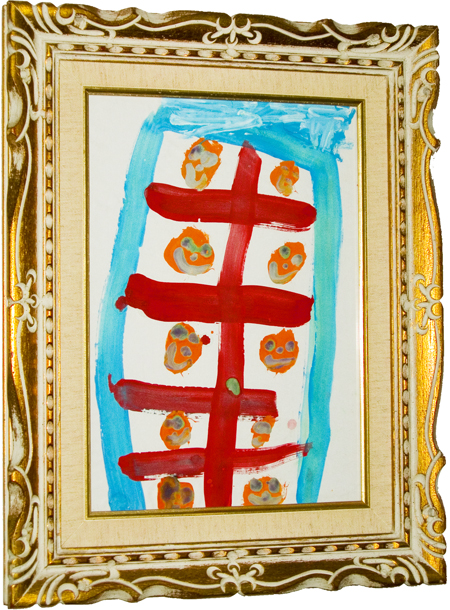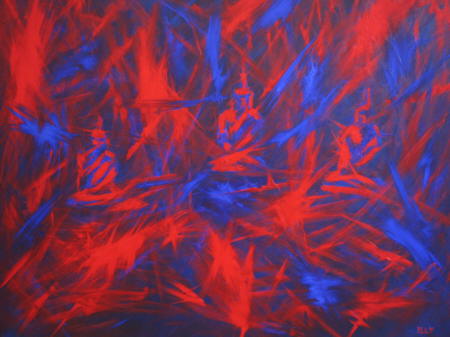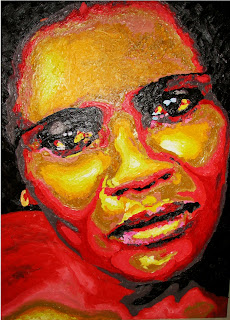Posted by Birgit Zipser on April 6th, 2007

Happy faces from all windows of a skyscraper merging with the blue sky as painted by a little girl visiting her grandparents in Manhattan in the 1970s.
The grandparents, living in an apartment complex of the garment district, introduced Nina to the culture of this big city.
The Jewish grandparents led a complicated life, balancing jobs with their struggle for social justice in this country, and to their granddaughter, they offered the unsullied joys of Manhattan.
Disasters happen, skyscrapers may topple. This painting celebrates the possibility of joy and innocence.
Posted by Richard Rothstein on March 25th, 2007
From the mid 1970s until the late 1990s, the Times Square area hosted three completely illegal, outrageous and brazen gay whore houses: The Gaiety, Show Palace and Eros. Show Palace and Eros survived until the late 90s, The Gaiety hung on–thanks to the patronage of many influential and prominent Manhattanites–through March of 2005. But even with the patronage of icons of the New York performing arts world and several entertainment industry moguls, the Internet ultimately proved to be too fierce of a competitor and Denise the very professional and always courteous Greek lady who owned this establishment shuttered the doors, collected her Drachmas and retired to Lesbos (not actually Lesbos, but you get the idea) after 30 years of peddling boys to men.

The cover story that allowed the authorities to turn a blind eye to these whorehouses was simple. They were not whorehouses; they were burlesque houses where boys would strip, dance and display their merchandise. No liquor was served and the”theaters” fell under the protection of Off-Broadway regulations.
more… »
Posted by Angela Ferreira on March 20th, 2007

Title: Scrying
Medium: Pencil & Oil on canvas
Size: 140 x 78 cm
This painting was made with a technique I have discovered by reading posts from both Karl Zipser’s and Hanneke’s methods.
I have drawn directly from a combination of life and imagination on to the canvas, shading to some extent and completing it mostly.
When the drawing was absolutely right, then I covered the picture with thin layers of oil mixed with diluents to show some of the transparencies.
I finally overworked to the top leaving some parts of the pencil showing through and some other parts built up with colour and tone.

Posted by Richard Rothstein on March 18th, 2007

The Arts section of today’s The New York Times examines the strange history and odd future of an artist considered to be one of the geniuses of the 20th Century and possibly the greatest of the Abstract Expressionists. Ironically, he remains–by design–virtually unknown to the general public and this despite the fact that he may have been even more prolific than Picasso.

For those of you unfamiliar with Clyfford Still, he is most certainly the ultimate manifestation of an artist’s contempt for commercialism, museums, galleries and collectors. He is famous for denouncing the galleries and museums of the art world as Nazi gas chambers. After a brief period of selling and displaying some of his work, Still retreated to a remote farm in Maryland and spent the remaining decades of his life painting furiously, cursing critics and the commercial art world and hiding his work. In a one page will he specified that his body of work could never be sold, never be separated, never be shown next to another artist’s work and could only be shown to the pubic in a Clyfford Still museum that would be built by an American city and would exclusively house his entire collection.

more… »
Posted by Steve Durbin on March 11th, 2007

Trikaya
Last time I wrote a guest post here, it was very useful to receive everyone’s feedback and discussion. So firstly a big THANK YOU.
This time I’d like to dig a bit deeper, after all this is “Art & Perception”. So with that in mind, there are three paintings contained within this post; Above the Enchantment, Trikaya and Gaze of Hope, each of which will appear in an exhibition in April (all are 81cm x 102cm). The exhibition, titled “Insight”, is to encourage the viewer to look more deeply at what is seen and to contemplate, beyond taking things at face value. I’m therefore interested to understand what everyone perceives in these 3 paintings – you may recall that I use music during the painting process.
more… »
Posted by Richard Rothstein on March 11th, 2007

As I was wandering down 10th Avenue a couple of days ago, camera in hand, marveling at the amazing variety of shapes, colors and play of light I thought this is an artist’s guilty pleasure. I felt terribly lazy. I know I have a talented eye, but it is so easy to capture compositions and brilliant visuals in a matter of minutes compared to many 20th and 21st Century painters who struggled amd struggle for hours, days and even months to capture on canvas what an observant photographer can capture in a second.

Is time a factor in great art? And if not, why not? Picasso spit out paintings like a fecund rodent. Van Gogh produced something like 40 paintings in the last five minutes of his life–well–something like that. Other artists labor and struggle for months over one painting. The photographer is almost the Henry Ford Model T production line of work, especially with digital photography. Click. Click. Click. Delete. Click. Delete. Click, I actually find myself feeling guilty. I shouldn’t enjoy it so much and it should take much longer. This morning I was paid $1,000 plus a percentage for agreeing to post an online gallery with narration of 12 of my photographs in the Queer New York at Night series. Easiest and fastest $1,000 I’ve ever made. Guilt. And Jewish guilt which is the most refined vintage and vineyard of guilt, like a Vosne Romanee of guilt.
more… »
Posted by Sunil Gangadharan on March 8th, 2007
I have often found it difficult to frame a message by just painting a face. A lot of people ask me ‘OK, who is this – rather than – what are you trying to say by painting this face..’. Sometimes the title tends to reinforce the painting but few today tend to dwell on titles.
I got thinking about this more a couple of days back as I was reading a review in the New York Times about an exhibition “Citizens and Kings: Portraits in the Age of Revolution, 1760-1830” (underway at the Royal Academy of Arts in London, England). The portraits at the show tended to focus on the ‘message’ rather than the medium, movement or technique (as opposed to the majority of shows today which tend to focus on one or more of the latter). The article also made a reference to the fact that over time, the message tends to fade away while the techniques and talent employed in creating the work live on. While it is commendable that technique and talent stand the test of time (and should), exhibitions like these are relevant in showcasing the effects of social situations on paintings and how painters were influenced symbioticallyby the social milieu ultimately chronicling the society they lived in.
From the article in the NYT (I somehow got to it, but it might ask for a subscription):
“Yet this exhibition’s purpose is radically different: it is to dwell on the message, not the medium. Rather than celebrating the artists as such, it presents them as witnesses to the social and political convulsions of their times. It shows them recording a crucial moment of history as it unfolded.”
What does this painting tell you?

I am interested in your response before you look for my interpretation here.










